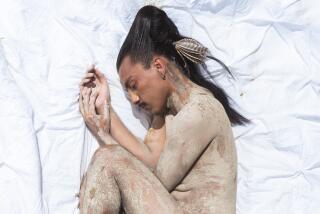Review: The Best Little Whorehouse in Texas, the farmhouse next door, and unexpected connections in between
Path-breaking artists help us to see the world afresh by challenging our habitual patterns of perception. They shock us into new awareness by joining the disparate and sundering the similar. Reality is distanced so that we may become reacquainted with it.
Suzanne Bocanegra, an adventurous visual artist who has been branching out into other disciplines, has been working in recent years on a series of artist lectures that are uncategorizable performance pieces. Memoir mixes with cultural history as a slideshow incorporates Bocanegra’s arresting visual sensibility in a theatrical exhibition that doesn’t so much set out to simulate her character as to tap into the wavelength of her febrile mind.
In “Farmhouse/Whorehouse,” presented by UCLA’s Center for the Art of Performance at the Theatre at Ace Hotel on Saturday, Bocanegra, sitting inconspicuously at a desk in dim light, feeds lines directly into an earpiece worn by actor Lili Taylor, who delivers a tantalizingly digressive talk. The retrospective address, vibrating with eccentric observations and quiet humor, centers on the memory of Bocanegra’s grandparents’ farm in La Grange, Texas.
This small, hardscrabble rustic oasis from Bocanegra’s childhood stood opposite the happily notorious Chicken Ranch brothel, better known as the Best Little Whorehouse in Texas. The odd juxtaposition of these seemingly opposite worlds leads to a frolicsome deconstruction of cultural binaries, which is a fancy way of saying that our minds are pried open to unexpected associations.
Written and created by Bocanegra, “Farmhouse/Whorehouse” is the third (and reportedly last) lecture in a set that includes “When a Priest Marries a Witch” (starring Paul Lazar) and “Bodycast” (starring Frances McDormand). The production with Taylor, directed by Lee Sunday Evans with discreet finesse, follows the looping train of Bocanegra’s thoughts with the confidence that, however far afield the discussion travels, there are always worthwhile connections to be teased out.
Here’s an example of the kaleidoscopic movement of the artist’s mind. Bocanegra’s experience of pregnancy, symbolically re-created through photographs of dummies with their stomachs opened and organs removed, gives rise to a meditation on death, which provokes a long disquisition on subsistence diets, like the one elaborated by the Mormon writer Esther Dickey in her book “Passport to Survival.”
Food and frugality, the chief concerns of Bocanegra’s grandparents, provide a bridge to this investigation of pioneer hardship and deprivation. The beauty of the landscape cannot conceal its harshness; the simplicity of a farmer’s life is the flip side of its unforgiving rigor. When Bocanegra was young, she took photographs of her grandparents’ wrinkled hands, which were ravaged by hard work. She recalls the kittens that her grandfather would drown rather than see starve. Sentimentality is a luxury afforded to those who don’t have to butcher their own meat.
The pastoral in painting and literature tend to portray a more serene vision of humanity’s relationship to nature. Disease and death tell a different story. Bocanegra isn’t trying to disabuse herself of false illusions so much as take in the cultural contradictions.
An old photograph of hippies sparks consideration of a 1960s fad that had those with little experience of the land proselytizing the necessity of returning to it. She ponders the impetus behind utopian communes, arriving at the wry conclusion that most of these experiments didn’t last, as people “discovered that human relations are really complicated.”
As for the well-known whorehouse across the street from the farm, Bocanegra understands it now as a “social institution born of a sense of survival.” In this respect, it had much in common with her grandparents’ way of life, even if style was far more important to the apparently well-disciplined women who worked there.
“I don’t think anyone moved to the Chicken Ranch in search of fulfillment or happiness,” she says through Taylor with a degree of reverence for those trying to make the best of a bad set of options. The mood that is sustained is one of open-minded curiosity about the nature of our world and the way we choose to represent and remember it. (A clip from the film “The Best Little Whorehouse in Texas,” starring Dolly Parton and Burt Reynolds, hilariously demonstrates our penchant for turning history into kitsch.)
Taylor, wearing an androgynous black costume inspired by the women from the Oneida utopian community in upstate New York, isn’t engaged in an act of impersonation. At several points, she had to ask Bocanegra to repeat a line, but nothing interrupted her focus. Taylor, who maintains a tone of interior musing throughout, channels the artist’s sensibility magnificently through an ardor that is as modest as it is intense.
The performance, composed in thematic layers, is itself a kind of bricolage. Just as in the slideshow Jean-François Millet and Henri de Toulouse-Lautrec are drolly overlaid over Americana to reveal recurring patterns, Taylor and Bocanegra are placed on the stage in such a way as to reflect the story in a parallel light.
A bewitching theatrical curio, “Farmhouse/Whorehouse” anatomizes an artist’s way of seeking to open our eyes to the wondrous strangeness surrounding us.
Follow me @charlesmcnulty
More to Read
The biggest entertainment stories
Get our big stories about Hollywood, film, television, music, arts, culture and more right in your inbox as soon as they publish.
You may occasionally receive promotional content from the Los Angeles Times.











